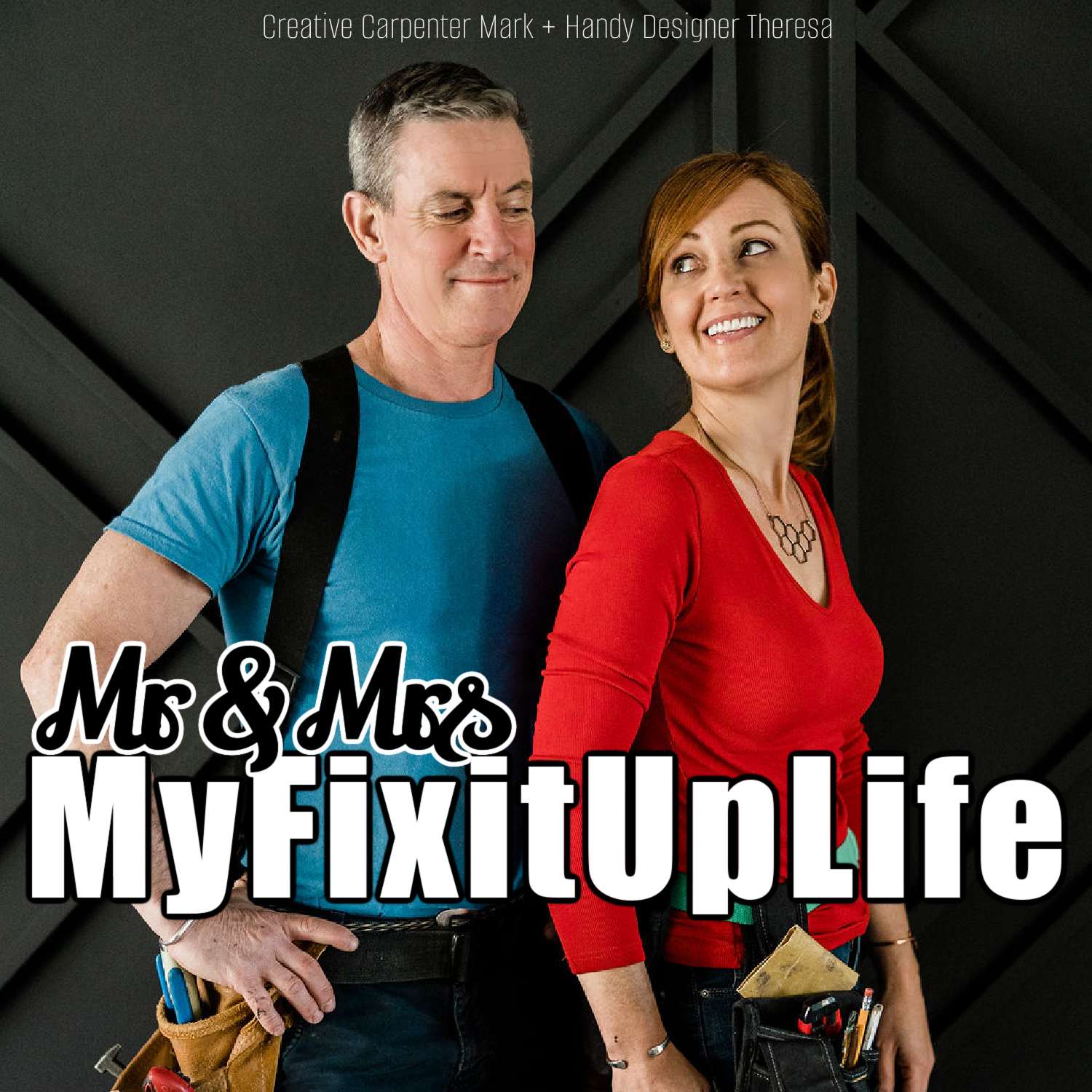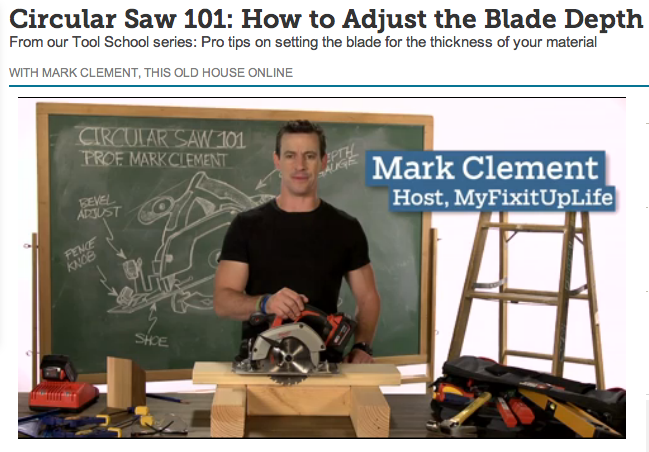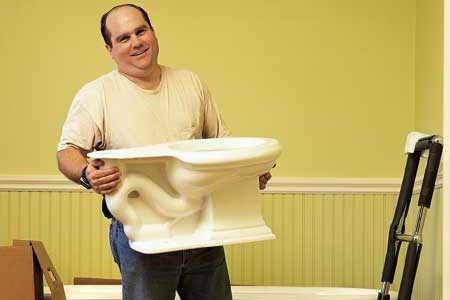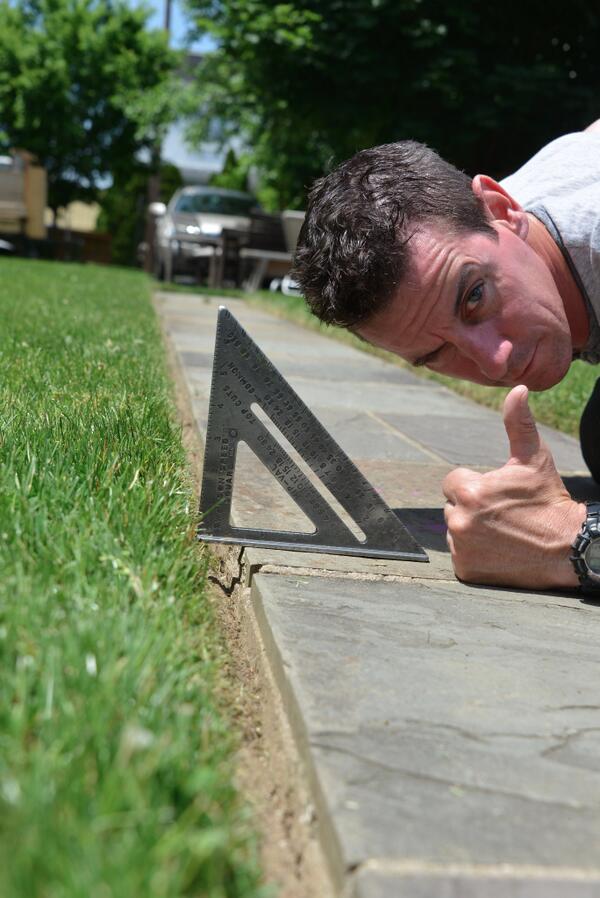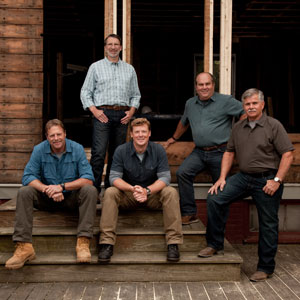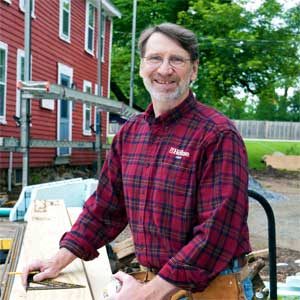This Old House host Kevin O’Connor talks universal design, landscaping, and roller skates with MyFixitUpLife hosts Mark and Theresa.
Mark: And you are back inside MyFixitUpLife with my wife Theresa.
Theresa: And my husband Mark.
 Mark: And we’re talking new and old. And we’re here with the new old This Old House/Ask This Old House host, Kevin O’Connor.
Mark: And we’re talking new and old. And we’re here with the new old This Old House/Ask This Old House host, Kevin O’Connor.
Theresa: I like new old, but I don’t know if that’s a compliment or a really good description.
Mark: You know Kevin O’Connor is in good shape.
Theresa: Yes.
Mark: Takes care of himself.
Theresa: Yes.
Mark: Nice guy.
Theresa: Yes.
Mark: Knows what he’s doing.
Theresa: Yes.
Mark: Which puts him in you don’t have to go the new old. How old are you Kevin? You don’t have to go into that.
Theresa: Yes. You don’t have to answer how old you are.
Kevin: Good to be here, guys, as always, talking to you.
Theresa: Well, thank you for joining us. I am excited because the Essex project is wrapping this week on a lot of stations around the country. For everybody who hasn’t been tuning in every week, you can check them out on ThisOldHouse.com, all of the episodes. But, you know, you tackled a concept, universal design, which I don’t know if you guys have done before on This Old House.
Kevin: Well, we’ve touched on the concept, but we’ve never actually made it the sort of driving focus of an entire project, and that’s what we did with Essex. The story here is that the homeowners who we’re working for, they are renovating this house for her parents. Her parents come and visit them a lot. They spend time in their house, because of the grandchildren. But they want to eventually move closer. They’re getting on in years. They’ve got some mobility issues. And as they renovate this house, they’re thinking, well, how can mom and dad live in this house comfortably, safely, and actually stay here, so that they can age in place. And that’s something that a lot of Americans are thinking about these days. So we hit it right on. We spent the entire project talking about those issues.
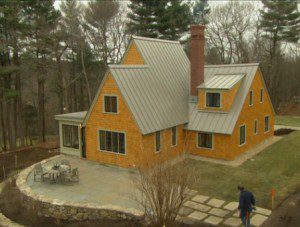
Mark: And backing up a little, because we listened to everything you just said, but are those the general components of universal design, when someone throws that term out?
Kevin: Well, you know, it’s a funny word. We’ve heard lots of different names for this in the course of the project. Some people think its handicapped accessibility. Some people call it just smart design. We didn’t really get hung up on the definition. What we were focused on was, if you’re going to go through renovation, or even a new build, what are the things that you can do that make it easier and more comfortable to live in a house? And what we found was, it doesn’t matter if you’re older, or if you’re young getting older. It doesn’t really matter what stage of life you’re in. All of the things that we employed in this renovation really make sense for anybody. So, just for example, from the simplest thing, it’s not a huge thing, but levers on doors. You know, rather than the round knob that you’re going to wrap your knuckles and fingers around, why not have a lever handle that you can push down with an elbow or a hand. It works for someone who’s older with arthritis. But it also works for a young mother who’s got a bag or a handful of groceries and wants to operate that door with her elbow. Tiny example, but it’s smart thinking, smart design that can work for anybody. So why not employ it?
Mark: Totally get where you’re going with that. And so, another layer to that question is, is universal design something that can be remodeled into a home like you did with This Old House, and I guess I’ll use the word affordably? Or is it better to be employed in, say, a new construction model?
Kevin: Well, I mean, if you’re going to do new construction, you should absolutely incorporate it. Why wouldn’t you? You know, why wouldn’t you make the doorways just a little bit wider, so if you ever had someone in the family who was in a wheelchair that they could get through comfortably. Why wouldn’t you build a brand new bathroom without a curb to the shower? So yes, in new construction it makes perfect sense. But in renovation I think it makes sense for some things. I mean, we saw the guy who built a new house and he incorporated an elevator shaft in the house. Now he had it as a pantry as its current state, but it was built so that it could accommodate an elevator in the future. That’s probably a very expensive, and maybe unnecessary retrofit. But there are lots of things when you are renovating a house that you can incorporate. If you’re going to do a new bathroom, well, why wouldn’t you think about putting a vanity in that you might be able to wheel up to, or a comfort height toilet, or a shower big enough to accommodate that wheelchair. Or even to have a seat and a good grab bar in the shower. Why would you do a bathroom renovation and not include those things? They’re small little additions, but they can make a world of difference if you’ve got any mobility issues in the future. So, you know, we show things that apply to new construction, but mostly things that apply to renovation.
Mark: Well, the first thing that comes to mind with curbless showers is I could skateboard in there.
Theresa: Really?
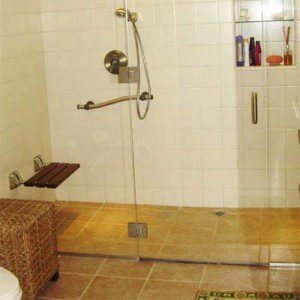
Mark: You just wheel right in. Skate in, and then you do like the round thing. You skate right up, turn the water on. Before it’s hot you’re out of the way, and you skate back in again. It’s a very exciting shower. You need pads and a helmet.
Theresa: I’m kind of thinking of you on roller skates or roller blades doing that.
Mark: Roller skates.
Theresa: Like you’re roller blading around in circles, and you’ve got multiple shower heads going and you’re just going crazy.
Mark: Sure, roller skates #alsdiner.
Kevin: Theresa, you may have images of Mark roller blading in and out of the shower, but that’s not really an image that comes into my mind. At least not comfortably. Sorry.
Theresa: I’m sorry. Let’s try to avoid that whole image for you.
Kevin: Thank you.
Theresa: But it seems to me that it just makes sense if you’re building new or if you are renovating to incorporate products that make sense for getting older, because we all get older. No matter how much botox or anything else that you can use, or how technology is changing so that we can morph into sort of like half-robot half-human kind of thing in 20 or 30 years.
Mark: I’m actually up to my neck right now in olive oil, just so everyone knows. I want to keep my skin, you know what I mean.
Kevin: I know what you mean.
Theresa: You know how much we want to preserve ourselves, or do like the cryogenics, or whatever it is. But, you know, it seems like it should be standard in new house construction, is to do all of these things that make it so that you can live in your house for your whole entire life, and not have to move or have to renovate because of, you know, different kinds of aging issues, or if someone gets ill. Or even for kids, too, it just makes sense.
Kevin: Another term that we heard for this is human centered design, and I think that probably hits sort of to the core of the whole idea. You know, as opposed, anything associated with age or mobility. Just human centered design. Things that just make good sense for the way we live our lives.
Theresa: Now, are you getting letters from PETA because of that?
Kevin: Fortunately I don’t have to read the letters.
Theresa: Okay. I just imagine that you might get more of like a video message, all those cat videos on YouTube. They might be “Meow, meow.”
Mark: Has anybody ever asked you, you or Tom or Norm. Can you make me one of those cat towers that’s wrapped in carpet samples?
Kevin: Uh, I don’t think we’ve gotten that request yet, to tell you the truth. We’ve gotten . . . We’ve done a dog house. We’ve done some other pet related things, but I’m not familiar with the cat tower request. That might be a first.
Mark: Yeah. Norm would dovetail it, and then Tom would say, “Well, we have to cover this in carpet,” and “Where are the tunnels,” and “Can we use PVC for this.” Yeah.
Kevin: I have no doubt that Tommy would tell us that he made one of these things when he was a kid, when he was 3 years old working for his dad. When he finished digging the trenches his dad made him make a cat tower out of carpet. No doubt he’d be telling the truth. The guy’s done it all. He’s absolutely done it all.
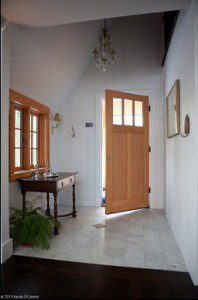
Theresa: I have to get back to the Essex house, too. Because I saw a picture that you tweeted out, and it’s @kevinoconnortoh on Twitter, of the front entry of the house where there is shiplap walls and reclaimed marble tiles. Now, where are those marble tiles reclaimed from?
Kevin: Those were taken, we’re pretty sure that their original home was a brownstone in Boston. They came out of a brownstone. That was probably well over 100 years ago. They came out of the brownstone, and when we got our hands on them, they were already at a salvage facility. So we went and grabbed them. We got enough for that entryway. We spent quite a bit of time cleaning them up. As you can imagine, they had sort of the old mud job mortar on the back and sides and stuff. But we cleaned them up and we put them back down into the house. It looked good. We liked the sort of reclaim story. But I think more importantly, you couldn’t really buy tile that looked like that on the marketplace right now. They had that worn look. They had been around in someone else’s. They had been underfoot for 100 years. And so that’s why we used them. And the key thing, if you look at the photo. The key thing is, there was no threshold at the door, and there’s no threshold between the transition of front door, marble foyer, and wood floor going throughout the house.
Mark: Oh. You do have to look closely to see that, but yeah. That is true. So that begs the question, from inside to outside, human centered design or universal design, whatever we’re calling it. There can’t be like stairs out there. There’s got to be a ramp out to the driveway, or something of that nature. Is that right, in this house?
Kevin: Yeah, you’re not going to see any ramps. I mean, you could drive up this driveway, step out of your car, and without ever taking a step up, you could move from the driveway to the granite walk that leads to the blue stone patio, that leads to the stone porch into the marble foyer, across the floor, wood floor, out through the back four-season porch on the slate tiles, step out onto the second blue stone patio, and then to another granite walkway to the opposite side of the driveway. And those roller skates that you very unpleasantly were painting a picture of using in the shower, you could roller skate that entire distance, from outside all the way through the house and back out again without ever going over a bump. So we did quite a bit of grading. We made a lot of smart choices in terms of material. But we also made sure that we kept them at a very even plane.
Theresa: So you’re saying that this human centered design will allow my husband to take a shower, roll into the kitchen, get a cup of coffee, and roll out to the front drive to get his morning newspaper, all in one fell swoop?
Kevin: God willing he won’t… at the very least.
Mark: So if you can . . . So a good measure of having done a good job on this is that if you can play roller hockey in there, you’re in good shape.
 Kevin: In this case we pulled it off. I don’t mean to suggest that if you have steps you have not accomplished your goal properly. And in fact, the house that we worked on in Essex has a second floor, so there’s two bedrooms and a bathroom upstairs. You know, we didn’t eliminate stairs completely, but we did give our new homeowners the ability to live entirely on one floor, and we minimized any obstructions to being able to kind of walk comfortably or even wheel if they have to, through that, the critical functional spaces of the house.
Kevin: In this case we pulled it off. I don’t mean to suggest that if you have steps you have not accomplished your goal properly. And in fact, the house that we worked on in Essex has a second floor, so there’s two bedrooms and a bathroom upstairs. You know, we didn’t eliminate stairs completely, but we did give our new homeowners the ability to live entirely on one floor, and we minimized any obstructions to being able to kind of walk comfortably or even wheel if they have to, through that, the critical functional spaces of the house.
Theresa: Well, let’s get to a little bit more G-rated outside activity. I want to know how you’re getting ready for spring, and are you still working on your treehouse for your kids?
Kevin: Oh, you know about the treehouse, huh?
Theresa: Mm-hmm.
Kevin: Preparation for spring is about to start. We’ve still got snow on the ground up here in the wild northeast ofNew England. So as soon as all that snow’s gone, the kids are going to earn their allowance and go outside and pick up all the fallen branches. And then pretty soon after that, we’re raking all the pea stone back onto the driveway. Thank you plow guy. And then it’s going to be paying attention to the lawn. I obsess on my lawn. My wife will take care of the shrubs and the flowers, but I obsess on the lawn, and so I’ve got to do a double whammy of crabgrass preventer this year, because I had a terrible case of it last year. I’ve got to make sure that it’s nice and green for the soccer field and the baseball field.
Theresa: Okay. So, my husband likes to “walk the property” of our lawn, and he obsesses about it as well. I got him a lawn striper for his mower one year. He uses Milorganite for part of his whole process, which I think is hilarious, because you know what Milorganite is made from?
Kevin: I believe it’s something that comes out of the backside of an animal.
Theresa: Well it comes out from like human poop from Milwaukee.
Kevin: Wonderful.
Mark: It’s good stuff, though.
Theresa: It is good stuff.
Mark: It’s really good stuff.
 Theresa: There should be Milorganite.
Theresa: There should be Milorganite.
Kevin: Do you know Mr. Milorganite and his family? Do you know the Milorganite crew that actually . . .
Mark: It’s organic and processed and all those things. But I use it mostly in the August feeding to try to take some of the petrochemicals out and add human petrochemicals, I guess. But, yeah, it’s good stuff. And I’m with you too. So are you a lawn striper? Does your lawnmower leave stripes in your grass?
Kevin: Uh, no. I haven’t taken it to that level yet. But I am pleased to hear that you obsess on lawns, Mark. And I think it, I might be wrong, but I think it’s kind of a guy thing. I don’t know what it is, but I think it’s a guy thing. The lawn is sort of our domain generally. Why we obsess on it, I don’t know. But man, a good looking lawn? Like, I can’t wait to put a sprinkler system in and underground like rainwater collection tanks, so I can just keep this thing golf course ready. I just, I love it. And I love the fact that if I pull it off right, everybody in the family and the neighborhood is rolling around in the backyard during the middle of the summer having a blast, whether it’s the whiffle ball game, or the slip and slide, or just, you know, shoes off. It’s our own little piece of heaven.
Theresa: I think you guys obsess about your lawns because it goes back to your hunter days of like looking out and trying to get like the buffalo or whatever it is, and you’ve got you’ve got your spear, and your just, you know, out in the prairie or wherever you are. It’s very, you know, very masculine, very hot.
Mark: Yeah, Kevin. Remember that time when we were hunting buffalo together with spears?
Kevin: I do. I think I bagged one more than you, Mark.
Mark: I mean, yeah. In true Kevin O’Connor form, he has to win the break, and we have to take a break. So we’ll be back with more of MyFixitUpLife. Check out Kevin O’Connor and Kevin-O’Connor on Facebook, @kevinoconnortoh on Twitter, and check out episodes at ThisOldHouse.com. We’ll be back with more of MyFixitUpLife.
Check out more interviews with Kevin O’Connor and the guys from This Old House.
